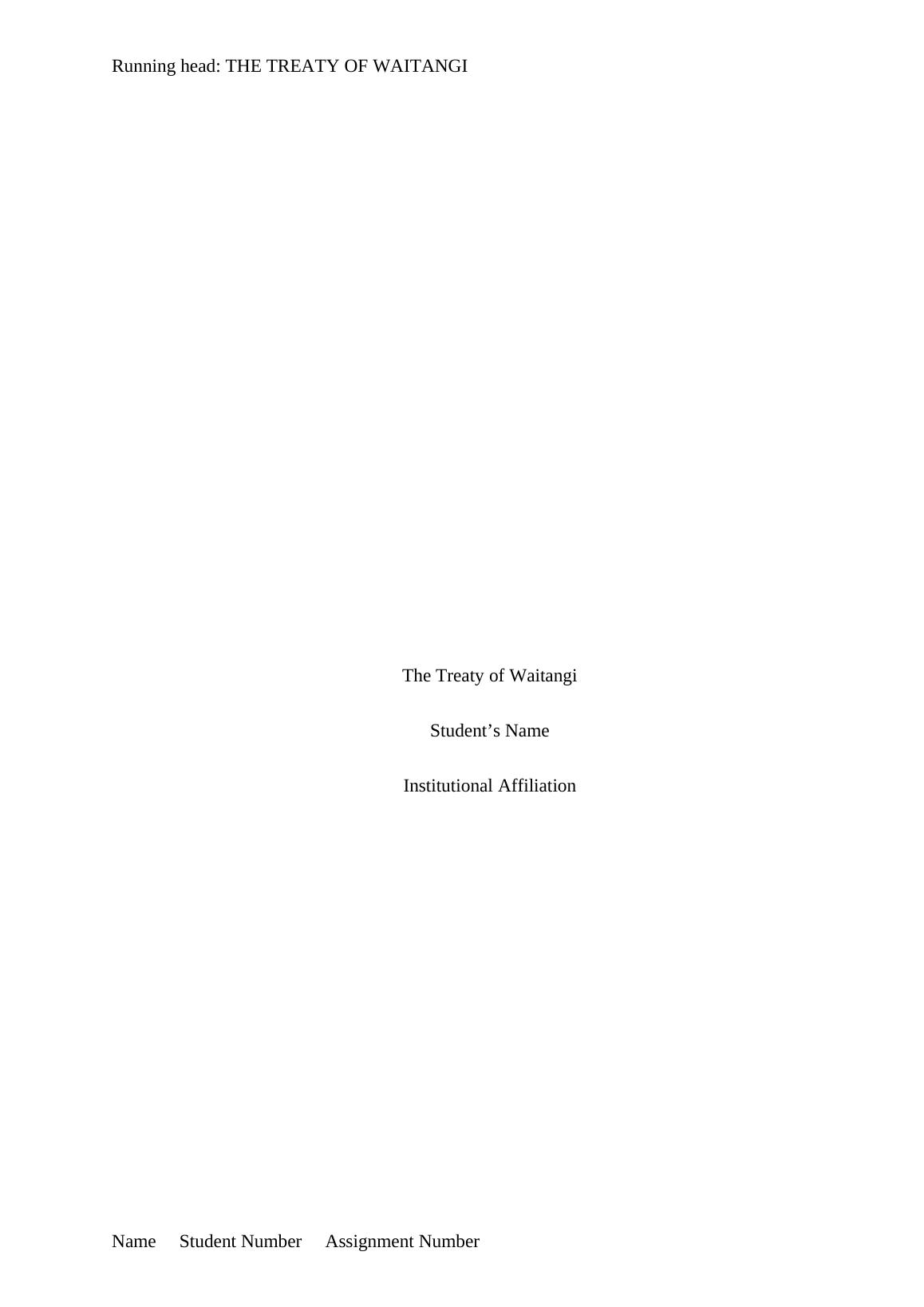The Treaty of Waitangi PDF
Added on 2021-05-27
7 Pages1850 Words77 Views
Running head: THE TREATY OF WAITANGIThe Treaty of WaitangiStudent’s NameInstitutional AffiliationName Student Number Assignment Number

THE TREATY OF WAITANGI2Question 1: The Treaty of Waitangia)Outline the context in which the Treaty of Waitangi was signed.The treaty of Waitangi was signed was signed on the 6th day of February in the year 1840. The date mentioned signifies the first time for the treaty to be signed. The treaty which involved representatives of the British Crown and more than 500 chiefs from Maori was signed at a place called Waitangi (just as the name of the treaty) in the Bay of Islands in New Zealand (Johnston, 2011). William Hobson was the lieutenant governor at the time. He was the one who had received instruction to establish sovereignty of the Britain government in New Zealand. He represented the British crown in the treaty (Johnston, 2013). There are several reasons why the British crown wanted to establish a treaty with the Maori. British wanted New Zealand to become a part of its jurisdiction areas. For that processto occur smoothly, there was need to sign a treaty with the Maori before other major European countries such as France and Germany did. This was one of the motivating factors. There were also some British whalers who were breaking British law in New Zealand. When questioned, they said that the British law did not apply to New Zealand. Since the missionaries considered this a great disrespect to the crown, they advocated for a treaty to have British law established in the country. The third reason was that British wanted to utilizenatural resources and buy land for settlement in New Zealand. To do this without resistance, it was necessary that they form a treaty. In a nutshell, these were the main reasons why the British crown wanted a treaty with the Maori.The treaty was presented to Maori chiefs for the first time on the 5th day of February in the year 1840. It was presented to more than 500 chiefs. On the 6th of February 1840 more than 40b chiefs signed the treaty. At the end of the whole process of treaty dissemination and translation, over 500 chiefs signed the treaty. There were two versions of the treaty: one Name Student Number Assignment Number

THE TREATY OF WAITANGI3written in Maori language and an English translation. Most of the chiefs signed the one written in Maori with only 39 of the chiefs signing the English translation. According to Tribunal (2010), some differences have been found to exist between the two versions.There were several reasons why the Maori signed the treaty. First, they wanted to helpstop trouble being caused by some British who lived in the country (Xuefei, 2018). Signing the treaty would establish British law and help curb any form of lawlessness. Secondly, the chiefs would have control over their tribes. Total power and authority would not go to the British. Thirdly, the missionaries advised the chiefs to be party to the treaty. Thirdly, as it waslikely to bring long lasting peace and stability to New Zealand with the establishment of British law and order. Fourth, the chiefs saw it as an opportunity to eliminate land deals with British traders who they termed as greedy. The traders would be controlled by the law stopping any illegal dealing. Fifth and lastly, Britain was a major power and having a treaty with them would mean protection for the Maori. It would also mean improved trade between the two countries. Additionally, they would be protected from France and other countries such as Germany. The treaty has three main articles. In the English version, the Maori would surrender/give up their sovereignty of New Zealand to Britain. The English version also indicates that the Maori gives the British absolute rights to buy the lands that they would like and in return have full rights of ownership of their lands and other possessions (Hayward and Wheen, 2015).The English version further outlines that the Maori would enjoy the same privileges and rights as the British subjects. There seems to have been some inconsistencies between the English and Maori versions (State Services Commission, 2005). For instance, in the Maori version the word sovereignty was presented as ‘katakana’ which means governance. Some of the Maori also thought that the British crown would only have control over British subjects. The English version guaranteed possession of all properties without anyName Student Number Assignment Number

End of preview
Want to access all the pages? Upload your documents or become a member.
Related Documents
Treaty of Waitangi Assignmentlg...
|10
|2109
|290
Treaty of Waitangi: Creation, Interpretations, and Differenceslg...
|7
|2125
|365
The Treaty of Waitangi in New Zealandlg...
|12
|3305
|479
Court of Appeal’s Incorporation of the Principles of Waitangi in the Decision on NZ Maori Council Vs Attorney Generallg...
|6
|1370
|186
The Treaty of Waitangi Studylg...
|5
|1631
|47
Organizational and Bio-Cultural Relations: Impact of Treaty of Waitangi on Business in New Zealandlg...
|12
|2785
|211
